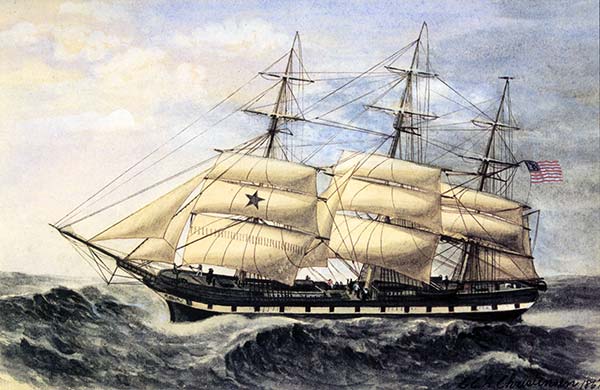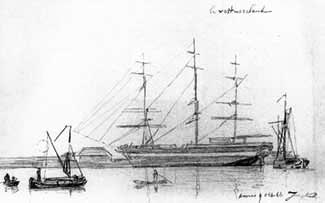Westmoreland

On Friday, April 18th, 1857, a company of emigrating Saints, numbering 536 souls, bound for Utah, sailed from Copenhagen on the steamer L.N. Hvidt, in charge of Elder Hector C. Haight, who accompanied the emigrants to England. Among the emigrants was the late Simon Peter Eggertsen of Provo, Utah. After a successful voyage the ship arrived at Grimsby, England, April 21st in the afternoon, thence the journey was continued the following day by rail to Liverpool, where the emigrants, together with four returning Utah Elders from Great Britain, went on board the ship Westmoreland and sailed from Liverpool, April 25th. In the evening of the 24th, while the ship still lay at anchor in the River Mersey, five young couples were married, namely: Carl C.A. Christensen and Eliza Haarby, Johan F.F. Dorius and Karen Fransen, Carl C.N. Dorius and Ellen G. Rolfsen, Lauritz Larsen and Anne M. Thomsen, and Jacob Bastian and Gertrud Petersen.
Here they were received by Elder Angus M. Cannon, who during the absence of President John Taylor, acted as emigration agent; he made the necessary arrangements for the journey of the company through the States. On the 2nd of June, the emigrants continued by rail from Philadelphia, and, traveling via the Baltimore and Wheeling, they arrived safely in Iowa City, Iowa, July 9th, 1857. This place was the outfitting point for the Saints who crossed the Plains in 1857, the same as in 1856. During the railroad journey, a Brother Hammer from Bornholm and three children died.

About the 15th of June, a part of the company commenced the journey toward the Valley from Iowa City with an ox-train, under the captaincy of Elder Matthias Cowley, while another fraction of the company, about the same time, commenced the journey across the Plains with handcarts under the leadership of Elder James P. Park. Several of the emigrants who had not sufficient means to continue the journey to the Valley that year, remained in the States for the purpose of earning money with which to continue the journey later. The ox-train, which consisted of 198 souls, 31 wagons, 122 oxen and 28 cows, arrived at Florence, Nebraska, July 2nd, 1857, in pretty good health; but when the handcart company reached that place the following day a number of the handcart emigrants were sick, owing to the change of food and climate, and also because of over-exertion.
Consequently, a council was called for the purpose of considering their condition, and, after some discussion, it was decided by unanimous vote that the company should continue the journey at once and that all who were not strong enough to stand the journey should remain behind, so as not to become a burden to the company. The ox-train rolled out of Florence, July 6th, and the handcart company, which consisted of 330 souls, with 68 handcarts, 3 wagons and 10 mules, continued the journey from Florence, July 7th, under the leadership of Elder Chr. Christiansen, who returned home from a mission to the Western States. Both companies arrived safe and well in Salt Lake City, September 13th, 1857.
Notes…
Also see: Nicoali Sorensen's Account, of the Voyage from Denmark to America.